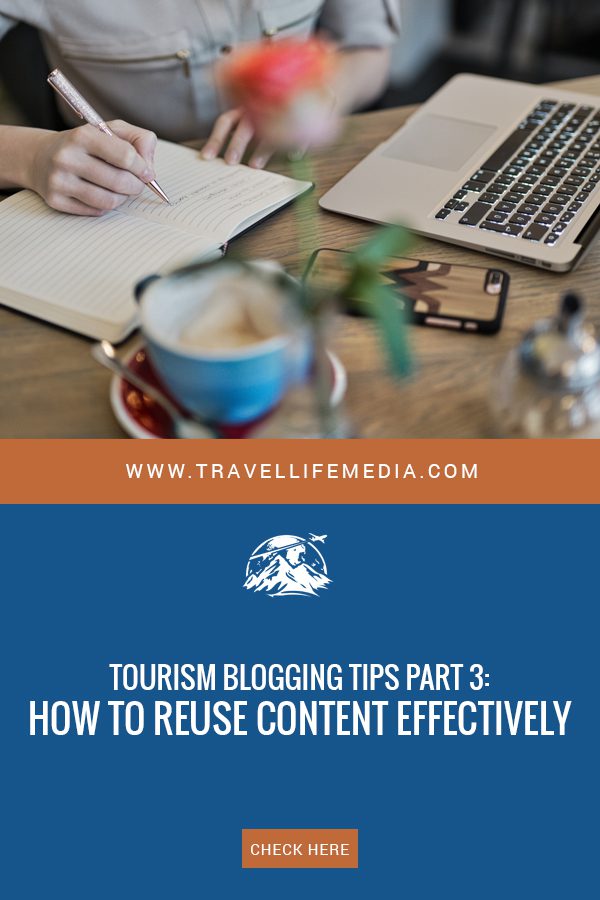In Part 3 of this series, on blogging in the tourism industry, learn about why content repurposing is necessary to save time and effort when creating your blog for tourism.
Do you have old posts that gained a lot of attention from your readers? The blogs or videos that helped many of your audience and have provided value to them. These successful posts are too good to just let them be where they are, right?
Here is where content repurposing works.
Also known as reusing content, it is like breathing a new life into your content. When you repurpose content, you take all or some elements of your content and reuse it again, and again, and again—in other ways and other places.
Definitely, reuse your content!
We consume information in different ways. Not all of us fancy listening to podcasts. Some may prefer reading a blog while sipping coffee in the morning. Others may want to take in information visually. For this reason, many repurpose their content to expand their reach.
You should repurpose content to:
- Save time. Time is a valuable asset to tour operators and other professionals in the tourism industry. We know it can be challenging to determine what to blog next, especially if you don’t have a master list of tourism blog ideas, which we tackled in Part 2 of the series. What do you think of getting one old post and making new content out of it? Yes, repurposing your content saves you a lot of time in the content creation process, which means more to spend on more valuable business matters.
- Save energy. Content creation is actually more taxing than many think it is. With content repurposing, you don’t only save precious time but also energy to create new content.
- Expand reach. Repurposed content usually comes in a new format, and a good example of it is this podcast-turned-blog. You get to present your content in many other ways, thus reaching more people, even those that haven’t heard your brand. You may create an infographic from one of your blog posts, or write a blog about the major points discussed in your YouTube video.
- Create more content. One post can lead to a lot more pieces of content. Instead of creating content from scratch, you can take a piece of your existing content and focus on it. You can also expand a part of the content to cover more points. You can develop more content suitable for each platform you have, such as a blog, social media, or YouTube channel.
How to Reuse Your Content Effectively
Content repurposing is not just simply reusing old content, hitting copy-paste, and then sharing it again and again. It’s more than that. It’s taking existing content, changing some parts or its form to make it more suitable to specific platforms, and adding value to it.
Remember that the goal is not repurposed content. It’s having people consume quality posts that will prompt them to share and promote them. This way, your content can reach more and more people.
Plan to Repurpose Content
Much like Part 1: setting blogging goals and mindset, make it a habit to consider content repurposing even before you start the content creation process. Before working on a video, podcast, or blog post, ask yourself: “Can this be broken into smaller pieces? How can I do that?”, “Is it possible to transform this content into another form?”, “What platforms can I share it on?”.
Planning content repurposing ahead allows you to point out micro pieces where you can build content off. There are many ways to repurpose content, and thinking ahead about how you can reuse your content is a time-saver and adds value to the process.
Check Your Successful Posts
When choosing which content to repurpose, it helps to check your analytics. See which posts are the most successful—meaning, the ones that have the most engagement and drive the highest traffic to your site. This is the content that resonated with your audience the most. Take a successful post and find ways to content reuse to reach new and existing audiences.
Create An Outline of Your Content
Another way to effectively repurpose content is to create an outline before you begin. It doesn’t only save you time, but it makes the whole content reuse process organized. Start with an intro, then list the main points of your content. Lastly, add a call to action. This works best when writing a blog post or a script for a video or audio.
A Good Example
Let’s look at a video from Black Cab Heritage Tours as an example. About 17-minute long, the said video takes us on a tour of the different iconic stadiums in London, including Wembley, Wimbledon, Twickenham, and Lord’s Cricket Ground.
The video is great content, but what could have been even greater is to repurpose it to reach more people—those who aren’t much into watching a 17-minute video or don’t have time for it.
With just a video, there are tons of possibilities, including:
- Listicles, such as “Top 5 Reasons Why You Should Visit Iconic London Stadiums”.
- Infographics that show a map of the London stadiums, plus quick fun facts about each stadium. They can post this on social media, adding a link back to the original video.
- Short clips, preferably of the intro of each stadium, which they can use as teaser videos to be posted on social media. These clips can be edited to fit as an Instagram post or story.
- A written blog post about the stadiums. The introduction of the blog post can be used as the description of their YouTube video.
- Written blog posts from different parts or elements of the tour. For instance, a blog post for each stadium, “Top Stadiums for Music”, “Top Stadiums for Sports”, “Best Stadiums to Visit at Night”, “Best Stadiums for Kids”, and so on.
- A timely written blog post about “How to Safely Visit the Top Iconic London Stadiums During the Pandemic” that you can update as regulations change.
- Images of each stadium, highlighting key points that make it special, such as the sports teams that play there or famous singers and musicians who held concerts there.
- Photos of sports teams (beware of copyright issues), or images of quotes by famous singers and musicians who performed at a specific stadium. They can post these images on social media, particularly Twitter, adding a link back to the video or blog.
- Images of quoted reviews by guests who enjoyed their time touring the stadiums. Add a link back to the video or blog.
- A virtual map that takes the audience on a virtual tour.
- A map of walking or driving tours to the stadiums.
- An infographic that contains instructions on how to visit the iconic London stadiums.
- An e-book that can be used as their lead magnet to attract more people.
- A podcast.
Where to Share Repurposed Content
There are a lot of ways and places to share your repurposed content and reach more people.
- Your website. Start by sharing repurposed content on your website. It may be another blog post about the best bike trails in Ottawa for beginners or a gallery of photos of those trails to appeal to people who want to see the places featured on your blog.
- Your social media accounts. Social media is one of the best platforms to share your content. Because in this age, who doesn’t have social media? Depending on the social media platform, your repurposed content may take different forms.
For example, a video for YouTube (which you can re-share on your Facebook, Instagram, or Twitter), an infographic or pictures for Facebook page, Instagram, Twitter, and Pinterest, and a short blog for LinkedIn and Quora.
- Your mailing list. You can share your repurposed content to your subscribers or email list in the form of a newsletter.
- Your groups and communities. Expand your reach in places where you can find a good number of possible future clients—tour and travel groups and communities. Share your tour packages and other content with people who most likely will need them.
- Your past guests, clients, suppliers, and other professionals you’ve worked with before. Introduce your content to them and ask them to have a look at it. If they love it, ask them to share it. Otherwise, ask for feedback and suggestions.
Key Tips on Sharing Repurposed Content
- Join Facebook and LinkedIn groups. Share your content without being spammy. You don’t want to leave a bad first impression, do you?
- Look for people who engage with the content you post on your Facebook personal page and create a group and invite them in. Share your content in the group.
- When you share your repurposed content on social media, tag people who liked your previous content.
- Post-long-form videos on IGTV, and shorter ones as IG stories.
- Tap on content aggregator websites like Reddit, Travel Blogger Community, or Growth Hackers. Content aggregators are websites that don’t produce their own content; instead, they gather content from different online sources and aggregate them in one easy-to-access location.
- Use Flipboard, a popular news aggregator app that’s available on both iOS and Android, to share your content, curate content, and build authority on a subject. Flipboard allows you to create different content categories. You can start adding relevant content to these categories but make sure you also share others’ content aside from your own. This way, you can build your authority on the platform, which can help you gain more followers and traffic for your own posts in return.
- Try sharing apps like Instapaper and Pocket.
- Share newsletter content of other tourism businesses, as long as it is great and relevant content.
- Repurpose content and reshare it AGAIN and AGAIN.
Repurposing content is a valuable and necessary strategy for content creators. It saves you time and energy, allows you to reach more people, and provides you with more content that can be presented through various forms and on different platforms. Adding value to your repurposed content is crucial to its success. So, whether brand new or repurposed, make sure the content you create is relevant to your brand and considers the needs of your audience.








